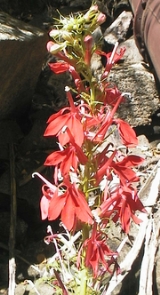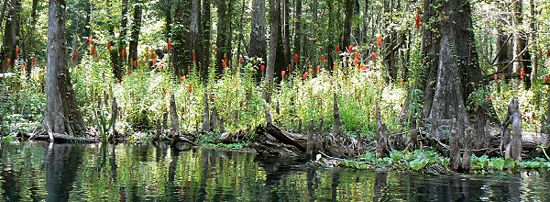
Lobelia cardinalis
Encyclopedia
Lobelia cardinalis is a species of Lobelia
native to the Americas
, from southeastern Canada
south through the eastern and southwestern United States
, Mexico
and Central America
to northern Colombia
. It grows to about a meter tall (when in flower) and has bright red flowers.
Cardinal flower is often cultivated for ornamental purposes and has also been used for medicinal purposes.
 size = 1-3 ft. H X 1 ft. W
size = 1-3 ft. H X 1 ft. W
It is a perennial
herbaceous plant
that grows up to 1.2 m tall and is found in wet places, streambanks, and swamps. The leaves
are up to 20 cm long and 5 cm broad, lanceolate
to oval, with a toothed margin. The flower
s are usually vibrant red, deeply five-lobed, up to 4 cm across; they are produced in an erect raceme
up to 70 cm tall during the summer to fall. Forms with white (f. alba) and pink (f. rosea) flowers are also known.
Lobelia cardinalis is related to two other Lobelia species in to the Eastern United States
, Lobelia inflata
(Indian Tobacco) and Lobelia siphilitica
(Great Lobelia); all display the characteristic "lip" petal near the opening of the flower and the "milky" liquid the plant excretes. L. siphilitica has blue flowers and is pollinated by bees, whereas L. cardinalis is red and is pollinated by hummingbirds.
L. cardinalis has been known to cause an upset in the digestive system when consumed.
.
In the wild it is pollinated by the ruby-throated hummingbird (Archilochus colubris).
North American indigenous peoples used root tea
for a number of intestinal ailments and syphilis
. Leaf teas were used by them for bronchial problems and colds, inter alia. The Meskwaki
people used it as part of an inhalant against catarrh
. Although not related to tobacco, it was apparently not smoked, but may have been chewed. The plant contains a number of alkaloid
s. As a member of the genus
Lobelia
, it is considered to be potentially toxic. Native Americans (the Penobscot tribes) smoked the dried leaves as a substitute for tobacco. Lobelia may have potential as a drug for, or in study of, neurological disorders.
Lobelia
Lobelia is a genus of flowering plant comprising 360–400 species, with a subcosmopolitan distribution primarily in tropical to warm temperate regions of the world, a few species extending into cooler temperate regions...
native to the Americas
Americas
The Americas, or America , are lands in the Western hemisphere, also known as the New World. In English, the plural form the Americas is often used to refer to the landmasses of North America and South America with their associated islands and regions, while the singular form America is primarily...
, from southeastern Canada
Canada
Canada is a North American country consisting of ten provinces and three territories. Located in the northern part of the continent, it extends from the Atlantic Ocean in the east to the Pacific Ocean in the west, and northward into the Arctic Ocean...
south through the eastern and southwestern United States
United States
The United States of America is a federal constitutional republic comprising fifty states and a federal district...
, Mexico
Mexico
The United Mexican States , commonly known as Mexico , is a federal constitutional republic in North America. It is bordered on the north by the United States; on the south and west by the Pacific Ocean; on the southeast by Guatemala, Belize, and the Caribbean Sea; and on the east by the Gulf of...
and Central America
Central America
Central America is the central geographic region of the Americas. It is the southernmost, isthmian portion of the North American continent, which connects with South America on the southeast. When considered part of the unified continental model, it is considered a subcontinent...
to northern Colombia
Colombia
Colombia, officially the Republic of Colombia , is a unitary constitutional republic comprising thirty-two departments. The country is located in northwestern South America, bordered to the east by Venezuela and Brazil; to the south by Ecuador and Peru; to the north by the Caribbean Sea; to the...
. It grows to about a meter tall (when in flower) and has bright red flowers.
Cardinal flower is often cultivated for ornamental purposes and has also been used for medicinal purposes.
Growth

It is a perennial
Perennial plant
A perennial plant or simply perennial is a plant that lives for more than two years. The term is often used to differentiate a plant from shorter lived annuals and biennials. The term is sometimes misused by commercial gardeners or horticulturalists to describe only herbaceous perennials...
herbaceous plant
Herbaceous plant
A herbaceous plant is a plant that has leaves and stems that die down at the end of the growing season to the soil level. They have no persistent woody stem above ground...
that grows up to 1.2 m tall and is found in wet places, streambanks, and swamps. The leaves
Leaf
A leaf is an organ of a vascular plant, as defined in botanical terms, and in particular in plant morphology. Foliage is a mass noun that refers to leaves as a feature of plants....
are up to 20 cm long and 5 cm broad, lanceolate
Leaf shape
In botany, leaf shape is characterised with the following terms :* Acicular : Slender and pointed, needle-like* Acuminate : Tapering to a long point...
to oval, with a toothed margin. The flower
Flower
A flower, sometimes known as a bloom or blossom, is the reproductive structure found in flowering plants . The biological function of a flower is to effect reproduction, usually by providing a mechanism for the union of sperm with eggs...
s are usually vibrant red, deeply five-lobed, up to 4 cm across; they are produced in an erect raceme
Raceme
A raceme is a type of inflorescence that is unbranched and indeterminate and bears pedicellate flowers — flowers having short floral stalks called pedicels — along the axis. In botany, axis means a shoot, in this case one bearing the flowers. In a raceme, the oldest flowers are borne...
up to 70 cm tall during the summer to fall. Forms with white (f. alba) and pink (f. rosea) flowers are also known.
Lobelia cardinalis is related to two other Lobelia species in to the Eastern United States
Eastern United States
The Eastern United States, the American East, or simply the East is traditionally defined as the states east of the Mississippi River. The first two tiers of states west of the Mississippi have traditionally been considered part of the West, but can be included in the East today; usually in...
, Lobelia inflata
Lobelia inflata
Lobelia inflata is a species of Lobelia native to eastern North America, from southeastern Canada south through the eastern United States to Alabama and west to Kansas.-Growth:...
(Indian Tobacco) and Lobelia siphilitica
Lobelia siphilitica
The Great Blue Lobelia is a species within the Campanulaceae family. It is an herbaceous, perennial dicot native to eastern and central Canada and United States. Growing up to a meter tall, it lives in zones 4 to 9 in moist to wet soils. It produces a spike of zygomorphic flowers in the late...
(Great Lobelia); all display the characteristic "lip" petal near the opening of the flower and the "milky" liquid the plant excretes. L. siphilitica has blue flowers and is pollinated by bees, whereas L. cardinalis is red and is pollinated by hummingbirds.
L. cardinalis has been known to cause an upset in the digestive system when consumed.
Etymology
It was introduced to Europe in the mid 1620s, where the name Cardinal flower was in use by 1629, likely due to the similarity of the flower's color to the vesture of Roman Catholic CardinalsCardinal (Catholicism)
A cardinal is a senior ecclesiastical official, usually an ordained bishop, and ecclesiastical prince of the Catholic Church. They are collectively known as the College of Cardinals, which as a body elects a new pope. The duties of the cardinals include attending the meetings of the College and...
.
Cultivation and uses
This plant is easily propagated by dividing and spreading out the young plants which form around the older mature plants each year. Although the plant is generally considered a perennial any one plant may only live 7 to 10 years and then die. To ensure that your whole collection of cardinal flowers do not die off at the same time be sure to propagate some new plant lines using seeds at least every 4 years. Human activity also can interfere with the wildlife when getting the original seeds for your collection of "cardinal flowers".Taking seeds or roots of lobelia cardinalis to start your collection will stunt the growth of the "cardinal flower" population.In the wild it is pollinated by the ruby-throated hummingbird (Archilochus colubris).
North American indigenous peoples used root tea
Tea
Tea is an aromatic beverage prepared by adding cured leaves of the Camellia sinensis plant to hot water. The term also refers to the plant itself. After water, tea is the most widely consumed beverage in the world...
for a number of intestinal ailments and syphilis
Syphilis
Syphilis is a sexually transmitted infection caused by the spirochete bacterium Treponema pallidum subspecies pallidum. The primary route of transmission is through sexual contact; however, it may also be transmitted from mother to fetus during pregnancy or at birth, resulting in congenital syphilis...
. Leaf teas were used by them for bronchial problems and colds, inter alia. The Meskwaki
Meskwaki
The Meskwaki are a Native American people often known to outsiders as the Fox tribe. They have often been closely linked to the Sauk people. In their own language, the Meskwaki call themselves Meshkwahkihaki, which means "the Red-Earths." Historically their homelands were in the Great Lakes region...
people used it as part of an inhalant against catarrh
Catarrh
Catarrh is a disorder of inflammation of the mucous membranes in one of the airways or cavities of the body. It can result in a thick exudate of mucus and white blood cells caused by the swelling of the mucous membranes in the head in response to an infection...
. Although not related to tobacco, it was apparently not smoked, but may have been chewed. The plant contains a number of alkaloid
Alkaloid
Alkaloids are a group of naturally occurring chemical compounds that contain mostly basic nitrogen atoms. This group also includes some related compounds with neutral and even weakly acidic properties. Also some synthetic compounds of similar structure are attributed to alkaloids...
s. As a member of the genus
Genus
In biology, a genus is a low-level taxonomic rank used in the biological classification of living and fossil organisms, which is an example of definition by genus and differentia...
Lobelia
Lobelia
Lobelia is a genus of flowering plant comprising 360–400 species, with a subcosmopolitan distribution primarily in tropical to warm temperate regions of the world, a few species extending into cooler temperate regions...
, it is considered to be potentially toxic. Native Americans (the Penobscot tribes) smoked the dried leaves as a substitute for tobacco. Lobelia may have potential as a drug for, or in study of, neurological disorders.

